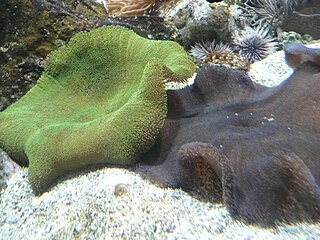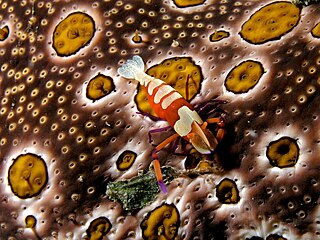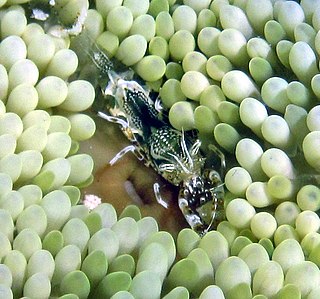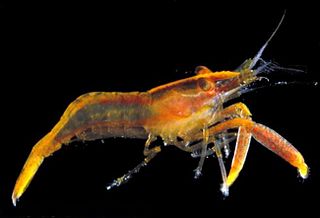
Stichodactyla haddoni, commonly known as Haddon's sea anemone, is a species of sea anemone belonging to the family Stichodactylidae. It is found in the Indo-Pacific area.

Astropyga radiata, the red urchin, fire urchin, false fire urchin or blue-spotted urchin, is a species of sea urchin in the family Diadematidae. It is a large species with long spines and is found in the tropical Indo-Pacific region. It was first described in 1778 by the German naturalist Nathaniel Gottfried Leske.

Ancylomenes magnificus, also known as the magnificent anemone shrimp, is a species of cleaner shrimp common to the Western Pacific Ocean at depths of 3–29 metres (10–95 ft). They are commonly found on stony coral, Catalaphyllia and the sea anemone, Dofleinia armata.
Neville Coleman OAM was an Australian naturalist, underwater nature photographer, writer, publisher and educator.

Periclimenes imperator, known as the emperor shrimp, is a species of shrimp with a wide distribution across the Indo-Pacific. It lives commensally on a number of hosts, including the sea slug Hexabranchus. A. J. Bruce first described it in 1967 based on eight specimens ranging from 4 millimetres (0.16 in) to 7.6 millimetres (0.30 in), and found Periclimenes rex to be its best resemblance.
Periclimenes dardanicola is a species of shrimp found in the western Pacific Ocean. It lives in association with sea anemones that live on the gastropod shells carried by hermit crabs. It was first named by Alexander J. Bruce and Junji Okuno in 2006. It is mainly white, and grows up to a carapace length of 4 mm (0.16 in).

Asthenosoma marisrubri aka Red Sea fire urchin and toxic leather sea urchin , is a relatively common sea urchin with a widespread distribution in the Indo-Pacific, and was till 1998 considered a color variant of Asthenosoma varium. Sea urchins are close relatives of starfish, crinoids, brittle stars and sea cucumbers, all being echinoderms.

Asthenosoma varium is a sea urchin. Growing up to 25 cm (10 in) in diameter, it lives on sand and rubble sea bottoms in the Indo-Pacific, from the Red Sea to Australia and Southern Japan. Its venom tipped spines, with distinctive globular swellings below the tip, can inflict a painful sting if handled; the pain lasts as long as several hours. This capacity, perhaps coupled with its reddish-brown colour, has given it the common name fire urchin; other commonly used names are Pacific fire urchin, elusive sea urchin, variable fire urchin, and electric sea urchin.

Ancylomenes pedersoni, sometimes known as Pederson's shrimp and Pederson's cleaner shrimp, is a species of cleaner shrimp. It is part of the genus Ancylomenes and was described in 1958 by Fenner A. Chace Jr. as Periclimenes pedersoni. Ancylomenes pedersoni is found in the Caribbean Sea, often associated with a sea anemone, at depths of 1 to 15 metres. They are often found on the reefs off Bermuda.

Periclimenes brevicarpalis, the glass anemone shrimp or peacock-tail anemone shrimp, is a species of shrimp belonging to the family Palaemonidae.

Ancylomenes venustus, also known as the graceful anemone shrimp, is a species of shrimp which belongs to the family of the Palaemonidae. This species is found in the tropical waters from the centre of the Indo-Pacific biogeographical area. A. venustus lives in association with scleractinians and actiniarians and is a cleaner shrimp.
Cuapetes lacertae, previously known as Periclimenes lacertae, is a species of shrimp belonging to the family Palaemonidae. Its name is due to the fact the first specimen was collected from Lizard Island: lacerta being Latin for "lizard".

Ancylomenes holthuisi is a species of marine shrimp in the family Palaemonidae. It was first described in 1969 by A.J. Bruce as Periclimenes holthuisi.

Periclimenes rathbunae is a species of shrimp in the family Palaemonidae, also known as the sun anemone shrimp. It is found in the Caribbean Sea, the Gulf of Mexico, Florida and the Bahamas. It was first described by American biologist Waldo LaSalle Schmitt in 1924 and named in honor of American zoologist Mary J. Rathbun. This shrimp is usually found living in association with the sea anemone Stichodactyla helianthus or occasionally with Condylactis gigantea.

Periclimenes, commonly known as glass shrimp or cleaner shrimp, is a commensal and often symbiotic genus of semi-transparent shrimp within the family Palaemonidae. Species of this large genus feature a wide variety of coloration and patterns, widespread distribution throughout much of the world's tropical oceans, and are often sought out for aquarium trade.

Zenopontonia is a genus of shrimp within the family Palaemonidae.

Periclimenes carinidactylus is a species of saltwater shrimp found in Australian coastal waters and was first described in 1969 by Alexander James Bruce.
Periclimenes madreporae is a species of saltwater shrimp in the family, Palaemonidae, and was first described in 1969 by Alexander James Bruce.
Periclimenes mahei is a species of saltwater shrimp in the family, Palaemonidae, and was first described in 1969 by Alexander James Bruce.
Aatolana springthorpei is a species of crustaceans in the family Cirolanidae, first described by Stephen John Keable in 1998.














